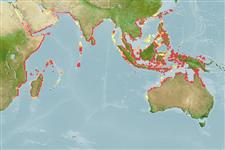Environment: milieu / climate zone / depth range / distribution range
Ecology
Marine; brackish; demersal; non-migratory; depth range 0 - 5 m (Ref. 6205). Tropical; 27°N - 30°S, 33°E - 148°E (Ref. 6205)
Indo-Pacific: South Africa, northward to Pakistan, India, Myanmar, Indonesia, northern New Guinea, Thailand, Philippines, and Taiwan. Not recorded from southern New Guinea or Australia.
Size / Weight / Age
Maturity: Lm ? range ? - ? cm
Max length : 35.0 cm SL male/unsexed; (Ref. 6205)
Dorsal spines (total): 12 - 13; Dorsal soft rays (total): 20 - 21; Anal spines: 2; Anal soft rays: 22 - 23; Vertebrae: 35. The first ray of the pelvic fin is modified into a laterally compressed thickened club-like structure. The swim bladder is reduced in size. There is no duct-like process from the ventral surface to the urogenital aperture.
Inhabit shallow coastal waters (Ref. 6205). Oviparous (Ref. 205). Marketed fresh (Ref. 6205).
Life cycle and mating behavior
Maturity | Reproduction | Spawning | Eggs | Fecundity | Larvae
McKay, R.J., 1992. FAO Species Catalogue. Vol. 14. Sillaginid fishes of the world (family Sillaginidae). An annotated and illustrated catalogue of the sillago, smelt or Indo-Pacific whiting species known to date. Rome: FAO. FAO Fish. Synop. 125(14):87p. (Ref. 6205)
IUCN Red List Status (Ref. 130435: Version 2024-2)
Threat to humans
Harmless
Human uses
Fisheries: commercial
Tools
Special reports
Download XML
Internet sources
Estimates based on models
Preferred temperature (Ref.
123201): 27.5 - 29.3, mean 28.7 °C (based on 1629 cells).
Phylogenetic diversity index (Ref.
82804): PD
50 = 1.0000 [Uniqueness, from 0.5 = low to 2.0 = high].
Bayesian length-weight: a=0.00661 (0.00381 - 0.01146), b=3.08 (2.92 - 3.24), in cm total length, based on LWR estimates for this species & (Sub)family-body (Ref.
93245).
Trophic level (Ref.
69278): 4.5 ±0.55 se; based on food items.
Resilience (Ref.
120179): Medium, minimum population doubling time 1.4 - 4.4 years (Preliminary K or Fecundity.).
Fishing Vulnerability (Ref.
59153): Low to moderate vulnerability (33 of 100).
